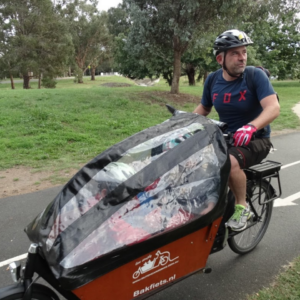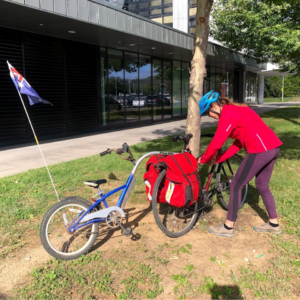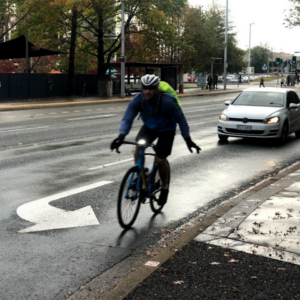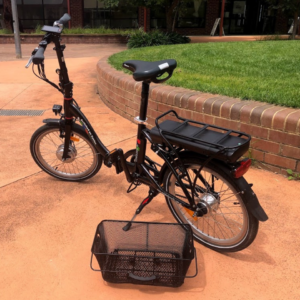
Gather your kit
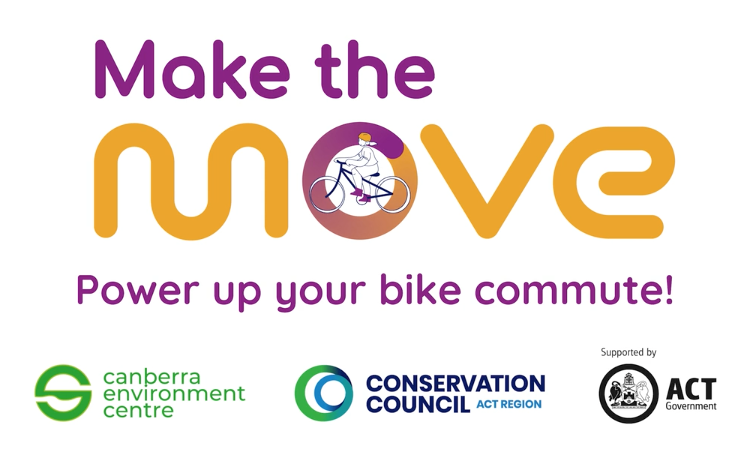
Choose the right commuter bike for comfort, safety and fun
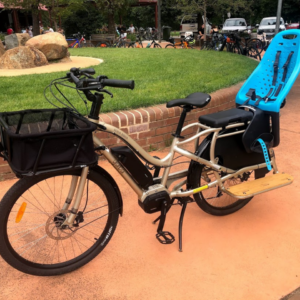
After you’ve identified your travel needs and planned your trips, you should have a good idea about how you might use a bike, eg to carry children, do long or short trips, lift it onto a bus bike rack, etc. There is an extensive range of bikes to choose from for a variety of specialist purposes eg mountain biking or road racing.
The information below focuses on ‘town’ or ‘city’ bikes –both push and electric– for urban commuting.
Budget
Generally, the more you spend, the lighter and more sophisticated the bike will be, but you don’t need to spend up big to get an entry level bike that will get you around town.

Many adults already own a pushbike. Dust it off, get it serviced or refurbished at a bike repair shop or the ReCyclery and take it for a spin.
If you don’t have a bike, visit the ReCyclery or Gumtree to find a second hand bike or head out to some bike shops to buy a new bike. Check out Switched On Cycles, the Canberra Electric Bike Library or bike shops to try an e-bike before you buy. Look online for specialist bikes such as Blind Freddy ebikes for people with mobility issues.
Your budget should include the purchase cost of the bike plus a helmet and any essential accessories plus insurance.
Features, size & fit
Frame shape & size
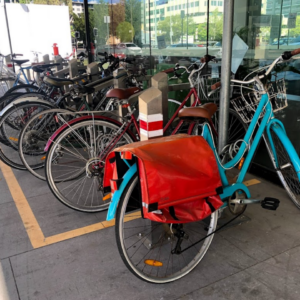 Frame height and length should correspond to both your leg length and your reach from the seat to the handlebars. Bikes were historically built with a horizontal cross bar or top tube to make the frame strong and rigid. Allow at least 5cm clearance between the top tube of the frame and your crotch when standing astride the bike with flat feet. Step-through frames were introduced to accommodate women’s long skirts, but these days are great for anyone who doesn’t want to swing their leg over the back of the bike to mount and dismount. The only drawback is that a step-through bike is more difficult to fit onto some car bike racks.
Frame height and length should correspond to both your leg length and your reach from the seat to the handlebars. Bikes were historically built with a horizontal cross bar or top tube to make the frame strong and rigid. Allow at least 5cm clearance between the top tube of the frame and your crotch when standing astride the bike with flat feet. Step-through frames were introduced to accommodate women’s long skirts, but these days are great for anyone who doesn’t want to swing their leg over the back of the bike to mount and dismount. The only drawback is that a step-through bike is more difficult to fit onto some car bike racks.
Folding vs fixed
Fixed frame bikes are generally more sturdy whereas folding bikes can be packed into the boot of a small car or into a caravan or carried onto a bus (at the discretion of the driver) – very handy as “transportable transport”, an alternative to using an externally mounted car bike rack and useful for the “last kilometre” of a journey.
Wheel size
The larger the wheel, the further the bike travels on a single pedal rotation, which can make you faster. However, in e-bikes, a smaller wheel works just as well and reduces the size and weight of the bike.
Weight
E-bikes tend to be heavy compared to pushbikes due to the weight of the motor and battery plus the extra strength required in the frame to withstand the power and torque of the motor. Consider the weight of different models if you expect to lift the bike frequently onto bus or car racks.
Handlebars
The higher the handlebars, the more upright your body will be, putting less strain on back and neck, and improving comfort and visibility. The lower the handlebars, the more prone and aerodynamic your body position will be. Riser handles are curved or straight, promoting an upright body position and wider hand position for easy steering control around town. Bullhorn handles bend up to the front allowing for a more prone body position good for climbing hills. Dropbars or ramshorn handles curve under, allowing a variety of hand and body positions for different terrain and aerodynamics, good for road racing. Racing bikes commonly have handlebars lower than the seat whereas town bikes have handlebars above the seat.
Seat/Saddle
More width and padding equals more support and comfort. The seat should be horizontal. For greatest power when pedalling, adjust the height so that when you are sitting on the seat with the ball of your foot on the pedal at the lowest point, your leg is almost but not quite fully extended (ie your knees should be slightly bent at the bottom of each pedal stroke). You should not be able to put your feet flat on the ground whilst sitting on the seat. Adjust the seat forward or backward to change the reach to the handlebars and your balance point over the pedals.
Gears, chain & brakes (“groupset”)
Enclosed hub gears are protected from grit and wear and are becoming common on e-bikes for smooth integration with electric power and changing gears when stopped. High-end bikes may feature a belt drive rather than a standard chain. Look for a chain guard to keep clothing from catching and protect the chain from mud. Disc brakes can be more effective in hilly terrain but are more expensive than standard rim brakes.
Tyre width & tread
Fatter tyres with deeper tread offer greater grip and comfort on a variety of surfaces, but are slower. Pumping tyres up to a higher pressure makes riding faster but bumpier; lower pressure absorbs more bumps and grips the road better in wet weather. Look for space in the forks to be able to fit mudguards to protect your clothing and gear from wheel splatter.
Pedals
Standard pedals allow for any kind of shoe. Cleat or clip-in pedals require compatible shoes that enable more efficient pedalling – you’ll need to learn how to twist your foot off the pedal to avoid falling when stopping the bike. Shoes with a recessed cleat teamed with one-sided pedals can be a good compromise.
Suspension & shock absorbers
Not needed for commuting although many seats will include some suspension for comfort.
Maintaining your bike
Save money by looking after your bike yourself or take it to a professional.
Most bike shops will offer free adjustments and the first service after purchase. They also offer repair and maintenance services. Or you can maintain your bike yourself. Get your bike serviced if it hasn’t been ridden for some time.
Regularly check the brake levers, pads and cables, lubricate the gears and chain with a specific bike lubricant, check tyre pressure and tread. Every six months, check and tighten nuts and bolts. Check and replace light batteries (if not connected to an e-bike battery).
The Canberra Environment Centre’s ReCyclery and ActSmart offer hands-on workshops to learn how to maintain or fix your bike and get instruction about how to repair a punctured tyre. Bicycle repair shops may also offer instruction, or watch some how-to videos online.
Look out for public repair bike stations and local business ‘bike stops’ that have facilities for bike riders, and ask your workplace to set up a station for basic maintenance.
Looking after the battery of an electric bike will maximise its lifespan, which may be anywhere from 400 to 1500 charge cycles – up to several years – depending how often you charge it. The more you pedal and the lower the power setting, the longer the battery lasts.
Gear & accessories
The range of accessories for bikes is extensive!
Here are suggestions for what to consider when getting started – many bikes will already have some of these fitted:
- A helmet is a legal requirement and protects your brain in the event of a crash. Make sure it fits snugly – it should stay in place when you shake your head. Check the position of sliders regularly. Always do up the chinstrap snugly – you should be able to fit two fingers.
- Lights, reflectors, mirrors to see and to be seen. Some lights are detachable and can be charged via USB cable.
- Racks, baskets, trailers, child seats: see more about kids and cargo [text link]
- Repair kit with spare inner tube (correct size!), tyre pump or gas canister, tyre lever, multi-tool, straps on under seat or inside frame void or to handlebars
- Bell
- Bike lock: a D-lock is the most secure method to lock the frame to a fixed pole or rack. Cable or chain or folding lock can be threaded through wheels and frame. The thicker or more solid the lock, the harder it is for a thief to quickly cut it off. Choose combination locks so you never lose keys.
- Mud guards and mud flaps
- Chain guard
- Stand
- Water bottle holder
- Handlebar pocket for keys, snacks, phone
- Home storage racks
- Tyre pump: on the bike, plus floor pump at home
- Navigation, dashcam, apps
- Car bike racks
Carrying cargo
There are many options for carrying large and small loads on bikes!
Hanging ordinary bags off the handlebars is NOT one of them – they can swing into the wheels or your feet and pull your bike off-balance. Cross-body satchels, sling bags or shoulder bags are also not ideal as they can slide around your body pulling you off-balance.
Here are some better options that can be fitted to almost any kind of bike (pushbike, e-bike, cargo bike). There is no perfect way to carry stuff, just figure out what works best for you.
Pouches & saddlebags
Pros: small pouches can be fitted to handlebars, under the seat or within the frame of the bike; ideal for small items like mobile phones, puncture repair kit, water bottle, raincoat.
Cons: limited capacity.
Backpacks
Pros: easy, versatile, goes with you on and off the bike, you probably already own one.
Cons: makes your back sweaty, raises your centre of gravity.
Baskets (wire or wicker)
Pros: easy to pop belongings into, some models detach so you can take it with you. Can be fitted to either the handlebars or a rack above the rear wheel.
Cons: large baskets on the handlebars obstruct your view of the front wheel and may make steering feel unwieldy depending on how they are attached; items could bounce out if not packed in well and secured with a strap or net. Baskets can sag or break if they are overloaded.
Racks
Pros: cheap to install, easy to load your choice of bag and secure with either a fitted spring-loaded catch or a stretchy strap.
Cons: standard racks are quite narrow so larger bags may be unstable.
Panniers
Pros: either double or single bag, fits onto a rear rack, keeps the weight of cargo low for good balance, items are securely contained and protected from weather and splashes. Can be fixed to the bike and large enough to drop your own bags into, or may detach easily to take with you instead of a separate bag – look for a shoulder strap or handle.
Cons: pannier bags can be less comfortable to carry on your person than a backpack.
Trailers
Pros: like a pick-up truck for your bike, useful if you need to carry large items like tradie toolboxes, musical instruments or weekly grocery shopping or your business supplies. The weight is low to the ground and off the bike; two wheels makes them stable. A good alternative to a cargo bike – removing the trailer allows the bike to be used separately.
Cons: they add length and width to the bike making them more awkward to manoeuvre and park.
Cargo bikes
Pros: longer, sturdier bikes, usually electric, many with carrying capacity in excess of 150kg – the minivan of bikes! Can be fitted with heavy duty versions of any of the above cargo accessories eg front tray basket capable of carrying two bags of groceries or a case of beer; rear bench seating for two children; customised pannier crates, boxes or trailers to carry heavy supplies.
Cons: longer, heavier bikes can be more difficult to balance, manoeuvre and park; more expensive than adding baskets, panniers or trailer to an existing pushbike.
See some other ways: ‘Urban biking: the art of carrying things by bike’
Carrying children and pets
There are many ways to get children around town on bikes. Small pets can go into baskets: children cannot!
Note that a bike rider must be at least 16 years old to carry children, all of whom must be under 10 years old and wearing helmets. All child seats must meet Australian safety standards: look for 5-point harness, foot rests & straps, handles, head supports, adjustable strap positions and padding for comfort as the child grows, seat padding and airflow.
Check that your bike is compatible before buying any attachment. Bike shops will help you fit them. Don’t use a child seat that has been involved in an accident.
Front-mounted baby seats
For children between 12 months and 2 years old, these mount either to the head tube of the bike frame or the handlebars. The child feels secure nestled between the parent’s arms and engaged looking forward. Some have a face rest. In general though, these seats have less head support, can be awkward for parent to see around/over the child to steer, can interfere with parent’s knees and pedaling action, and the high position raises the centre of gravity making balance less stable.
Front-mounted toddler seats
For children 2–4 years old, these mount to the frame. They consist of just a saddle and foot rests (no back rest or harness). They are less obstructive for the parent and have a lower weight point than the front-mounted baby seat. Children must support themselves but are likely to be more engaged in the ride.
Rear-mounted child seats
For children 12 months to 4–5 years old, these mount either to the bike frame or luggage rack. They have a lower centre of gravity than front-mounted seats, and don’t interfere with parent visibility or pedalling action. It can be harder for a parent to mount a bike with both a rear seat and a horizontal cross-bar frame.
Toddler trailer
Can carry 1 or 2 small children from 12 months old. 20-inch metal-rim wheels offer greater comfort and durability, and they are generally more weatherproof. Bench seats are more comfortable than sling seats, and the roll-cage protects children in the event of an accident. Weight is low and stable on two wheels. Some models convert into jogger strollers and be used in stroller mode for babies from 6 weeks old with additional padding. Additional benefits include being able to load some cargo (or pets!) in with the child, use the rear rack of the bike for other cargo, and detach the trailer (eg leave it at daycare) to use the bike independently.
Trailers do add length and width to the bike making them more awkward to manoeuvre and park. With no suspension they can be a bit rattly over uneven ground, and they are more expensive to purchase than seats.
Tag-along bikes or trailer cycles
Half-bikes that attach by a towbar to the parent bike like a tandem bike, enables kids to pedal, and can be handy getting home from daycare or school after a long day. Just watch out – if the child leans to one side, it can affect parent balance.
Tow bar or kit
A bar or frame that attaches to the back of the parent bike and lifts the front wheel of the child bike off the ground to tow like a tag-along bike. Good for enabling young children to ride their own bike and hitch up for longer rides. Can also affect parent balance if the child leans to one side.
Child bike tow rope
A cable or elasticated tow rope can be great for towing a competent young child’s bike up a hill or when they get tired. It is very portable and connects quickly to the parent bike seat post and child bike head post, and enables the child to ride and control their own bike. It’s not designed for general riding, but handy as a backup.
Child bucket
For 1, 2 or 3 children 12 months to as big as you can carry them. These cargo bikes generally have two wheels either side of a front bucket which is fitted out with bench seats and harnesses. The weight is low to the ground and stable, there is optional weather canopy and room for additional cargo. They can be long and wide to manoeuvre and park, so may take a little practice to manage.
Clothing
- A helmet is a legal requirement and protects your brain in the event of a crash. Make sure it fits snugly – it should stay in place when you shake your head. Check the position of sliders regularly. Always do up the chinstrap snugly – you should be able to fit two fingers.
- In cool or cold weather, wear light layers that you can take off if you get warm, a windproof jacket, a light beanie that fits snugly under your helmet, and gloves or mittens to protect against windchill.
- In warm weather, protect your skin from the sun with long sleeves or sunscreen.
- Flat shoes that attach securely to your feet, with rubber soles that grip the pedals are advisable (smooth leather soles may slide around on the pedals, thongs or ballet flats may fall off).
- Carry a raincoat or poncho for unexpected showers. Shoe covers are great for keeping shoes and socks dry.
- Light colours and/or a reflective high-vis jacket, vest, belt or sash over your clothes makes you visible to other road users. High-vis doesn’t have to look construction-site-ready: check out some more fashion-conscious ideas!
- Check that tight clothing still allows you to pedal and operate the bike comfortably including getting on and off.
- Keep loose clothing and shoe laces clear of wheels, pedals, gears and the chain – trouser clips are good for keeping pant legs contained.
More about electric bikes
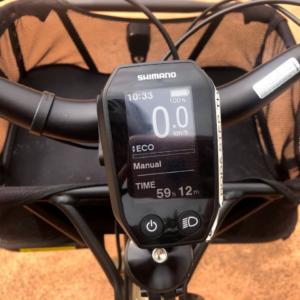
Electric bikes are fairly simple to operate.
Turn on the battery and the control panel, hop on and go. Adjust the power level and manual gears to suit the terrain and the amount of effort you want to put in. Like any digital device, it’s worth investing half an hour to read the manual and work through the settings so you understand battery and speed indicators for instance, and know how to reset the time or trip data etc.
Pros and cons (relative to pushbikes)
Motor-assisted acceleration on an electric bike helps you take off more quickly from stops, zoom along the flat, sail into headwinds and cruise up hills, saving time, effort and – critically for commuting – sweat.
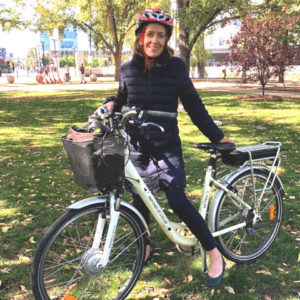
Motor-assisted acceleration on an electric bike helps you take off more quickly from stops, zoom along the flat, sail into headwinds and cruise up hills, saving time, effort and – critically for commuting – sweat. With 3-5 levels of power assist, they are ideal for carrying heavy loads, grocery shopping and children and are a great choice for anyone not fit or mobile enough to use a pushbike. The control panel displays a suite of data such as speed, trip length, battery strength. Most e-bikes have lights powered by the battery.
Electric bikes are more expensive to buy than an equivalent pushbike and can be quite heavy, often in excess of 20kg, making them harder to load on buses or cars, or manoeuvre up and down steps, although having electric power means there is often no need to combine transport modes. Long or wide cargo e-bikes can feel unwieldy until you get used to them, and take more space to turn and store. The battery requires routine charging and repairs may be more complex and costly than a pushbike. If the battery runs flat, e-bikes can be heavy to pedal. Like any expensive bike, e-bikes may be more of a target for thieves. Finally, lithium batteries cause environmental damage [text link] during mining, production and disposal.
Choosing a folding e-bike or basic city e-bike might help reduce the weight concern. Folding bikes can be packed into the boot of a small car or carried onto a bus (at the discretion of the driver) – very handy as “transportable transport”.
A good quality lock or off-street parking is useful to deter thieves. Looking after the battery will maximise its lifespan, then ensure it gets sent to a battery recycling centre.
Buying secondhand or retrofitting an electric motor to a suitable pushbike can be a cheaper alternative to a new e-bike, but make sure the frame of the existing bike is sturdy and the motor kit is compliant with Australian regulations.
Motors, batteries & range
There are two categories of electric bikes permitted for use as a bicycle in Australia.
“Pedelec” or pedal-electric bikes: the motor is limited to 250 watts. These will not activate unless the pedals are in motion and will cut out if you stop pedalling (eg freewheeling downhill or coming to a stop).
“Motor-assisted pedal-cycles”: the motor is limited to 200 watts and activated by a throttle, with pedalling optional (more like a motorbike).
Both types of electric bikes will cut out when the bike exceeds 25km/h. You can still travel faster than that under leg power and the motor will cut back in when the bike slows to below 25km/h. The transition between the electric motor and leg power should be smooth.
A mid-drive motor integrated with the pedal cranks drives the chain or belt and feels more like you have super strength when pedalling. They have greater battery efficiency but are generally more expensive than a hub drive and rarely seen on throttle-driven bikes. A hub motor installed on a front or, more commonly, rear wheel, feels more like the bike is being pushed or pulled by the motor, but is compatible with throttle-driven bikes. Most e-bikes have traditional manual gears like a pushbike in addition to the motor, allowing the bike to be ridden like a pushbike whether the motor is running or not, while others have only electric power levels. There are pros and cons of all these variations: the best way to choose is to try them out and see which you feel most comfortable with.
First-generation e-bikes used nickel-based batteries; current e-bikes mostly use the same, more efficient, lithium technology used in electric cars. Battery capacity is usually 400–500 Watt hours and 11–14 Amps, and lifespan may be anywhere from 400 to 1500 charge cycles, up to several years depending how often you charge it. The charger should have a power plug that fits into a standard Australian 240 Volt wall socket and a connection like any other electronic device that plugs into the battery. Full recharge takes around 5 hours and should be done when the charge falls below 30% and at least once every six weeks.
Distance or range on a full battery depends on many factors, particularly weight. The more you pedal and the lower the power setting, the longer the battery lasts. Lower-end bikes will last 30–60km, high-end bikes up to 120km. Replacement batteries for entry-level bikes cost around $400. High-end e-bikes often incorporate the battery into the frame which looks sleek but can’t be detached for charging separately and replacement can cost over $800. Also look for a battery that either locks securely to the bike or can be easily removed to take with you. Make sure you turn off the motor and battery when you stop!
Read more about environmental impacts and recycling of batteries.
Scooters & skateboards
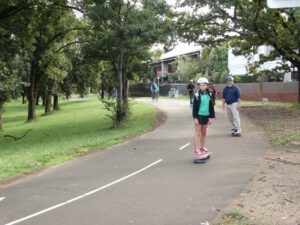
When ridden responsibly, scooters and skateboards can be a fun alternative to a short car trip or a long walk.
Scooters, skateboards, roller skates, roller blades, unicycles and other wheeled contraptions are all great fun and can be an excellent way to travel short distances relatively quickly. An easy alternative to a short car trip, they provide micro-mobility to connect to public transport. They lack cargo carrying capacity but offer speed and freedom.
Features, pros and cons
Scooters and skateboards etc can be wheeled onto light rail and buses at the driver’s discretion (they may refuse if the bus is full). They may be small enough to take into your workplace or other destinations, saving time compared to locking up a bike or parking a car.
Most scooters have a deck or platform around 40cm long, and width varies from about 10 to 20cm. Wider decks are more stable and comfortable especially for people with large feet. A lower deck is easier and more stable to push, but higher clearance above the ground will help to clear curbs and bumps. Some scooters have adjustable-height handlebars which is useful for anyone shorter or taller than average. Skateboards and one-wheel boards require (and build) confident balance, good core strength and sharp reflexes.
Scooters and skateboards cannot be ridden on roads unless there is no footpath. Footpaths can be bumpy and uneven, making for bone-rattling riding and risk of accident especially on small, solid wheels. Bigger, pneumatic (air-filled) tyres can overcome this and provide better grip, but check how accessible the valve is for inflation. Very few scooters have built-in cargo capacity to carry your stuff. Scooters can be quite unstable if you remove a hand from the handlebars, so take extra care when signaling turns.
Manual or kick scooters and skateboards
Human-powered scooters and skateboards are great for fitness and cutting travel time over short distances. They are generally lightweight and easy to carry when not being ridden. Speed is controlled by pushing off or stepping onto the ground with one foot. Scooters usually have brakes: either a simple fender over the back wheel that the rider presses down with one foot, or rim brakes operated by levers on the handlebars.
They are the most affordable wheeled mobility option. The life-cycle environmental impacts are extremely low and most of the materials can be recycled at the end of life.
Electric scooters and skateboards
Electric-powered scooters, segways, skateboards and one-wheels make getting up hills and covering longer distances quick and effortless compared to the effort of manual versions or brisk walking. An e-scooter is potentially a good option for people without the fitness or mobility to handle a kick scooter or long walk. They are significantly more expensive than manual versions but much less expensive than electric bikes.
E-scooters are speed limited to 25km/h and 200 Watts of power by Australian law in most states. The motor is generally integrated into one or both wheel hubs with no chain or gears. E-scooters may have either a twist-grip or button throttle to control the power and speed, plus a digital control panel that displays data such as speed, battery power, trip length. They usually have lights powered by the battery for increased visibility.
Batteries are typically lithium-ion, may be either built-in or detachable and typically have a lifespan of about 3 years depending on usage and how frequently they get recharged. Every 15 Watt hours will give the scooter approximately 1km of range.
Look for ABS disc brakes on both wheels operated by levers on the handlebars, good tyre size and tread, and suspension for a smoother ride. Alternatively, electric brakes slow the motor rather than the wheels and recycle energy back into the battery.
E-skateboards generally have a wireless handheld remote control that controls acceleration and braking. Other components are similar to e-scooters.
On the downside, electric scooters and skateboards have a higher injury rate and are less beneficial for health and fitness than manual versions or bicycles because the rider mostly stands still on the platform or deck when in motion and they can travel at speeds far in excess of the riders ability to recover on foot if they come off. E-scooters can be quite heavy, making them impractical to carry for many people, although privately owned e-scooters are generally lighter than share scheme versions (high-end scooters may be made from carbon fibre) and often foldable. Most are not designed to be pushed if the battery runs out. Being a heavy hunk of metal, e-scooters are liable to topple onto feet or swing into ankles, easily causing cuts and hefty bruises. Because they require little physical effort, riding electric scooters or skateboards in winter can be chilly. Lithium batteries cause environmental damage during mining, production and disposal, but can be recycled.
Operating & maintaining an e-scooter
Turn on the power. Holding the handlebars, push the stand up with your foot, place one foot on the platform, kick off with the grounded foot to get moving then gently apply power. Place your second foot on the platform once you are underway. Remember to turn off the power when you finish the trip, and plug into power to recharge fully whenever the battery level falls below 30% or more frequently if you need the battery at full charge for your next trip.
Keep your feet clear and maintain deliberate control when handling, unfolding, manoeuvring scooters up and down curbs etc to avoid the deck swinging into your ankles or other objects.
Regularly check the brakes, tyre pressure and tread (if applicable). Keep the wheels clean. Every six months, check and tighten any nuts and bolts. Check and replace light batteries (if not connected to an e-scooter battery). Replace the grip on the deck if it becomes worn and slippery.
Gear & accessories
Scooter riders are legally required to wear a properly fitting helmet. A bell is not legally required but is highly recommended.
Scooters lack the cargo carrying capacity of bicycles, but it may be possible to install a basket onto the handlebars or stem. Check compatibility before purchasing.
Carry a backpack rather than a single-strap satchel or shoulder bag that could swing around and throw you off-balance. For the same reason, do not hang bags from the handlebars.
Some scooters have fixed or removable seats, which may be useful for people with mobility issues, although the scooter may be less stable and a little harder to control.
As with cycling, you can wear regular clothes. Light layers and a windproof jacket allow easy adjustment for comfort. Pack a raincoat and spare shoes on wet days. Flat shoes that attach securely to your feet are essential. Padded gloves will keep your hands warm and absorb some of the rattle on rough paths. Add a high-vis reflective vest or sash to increase your visibility to other road and path users.
Wrist, elbow and knee guards are advisable, particular if using kick scooters or skateboards in skate parks.
Make your next move ...
Download the free guide and action planner and make your first move into clean transport

